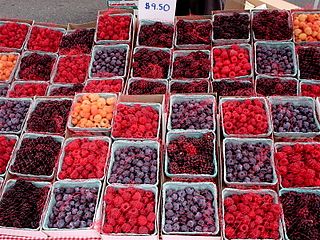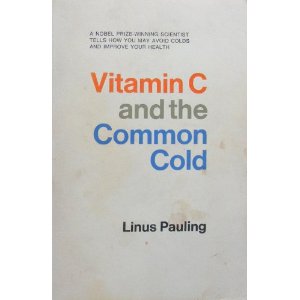
Linus Carl Pauling was an American chemist, biochemist, chemical engineer, peace activist, author, and educator. He published more than 1,200 papers and books, of which about 850 dealt with scientific topics. New Scientist called him one of the 20 greatest scientists of all time. For his scientific work, Pauling was awarded the Nobel Prize in Chemistry in 1954. For his peace activism, he was awarded the Nobel Peace Prize in 1962. He is one of five people to have won more than one Nobel Prize. Of these, he is the only person to have been awarded two unshared Nobel Prizes, and one of two people to be awarded Nobel Prizes in different fields, the other being Marie Curie.
A nutrient is a substance used by an organism to survive, grow, and reproduce. The requirement for dietary nutrient intake applies to animals, plants, fungi, and protists. Nutrients can be incorporated into cells for metabolic purposes or excreted by cells to create non-cellular structures, such as hair, scales, feathers, or exoskeletons. Some nutrients can be metabolically converted to smaller molecules in the process of releasing energy, such as for carbohydrates, lipids, proteins, and fermentation products, leading to end-products of water and carbon dioxide. All organisms require water. Essential nutrients for animals are the energy sources, some of the amino acids that are combined to create proteins, a subset of fatty acids, vitamins and certain minerals. Plants require more diverse minerals absorbed through roots, plus carbon dioxide and oxygen absorbed through leaves. Fungi live on dead or living organic matter and meet nutrient needs from their host.

Oregon State University (OSU) is a public land-grant research university based in Corvallis, Oregon. OSU offers more than 200 undergraduate-degree programs along with a variety of graduate and doctoral degrees through each college. It has the seventh-largest engineering college in the nation for 2023. Undergraduate enrollment for all colleges combined averages over 32,000 while an additional 5,000 students are engaged in post-graduate coursework through the university. In 2023, over 37,000 students were enrolled at OSU – making it the largest university in the state. Out-of-state students typically make up over one-quarter of the student body. Since its founding, over 272,000 students have graduated from OSU. The university is classified by the Carnegie Classification of Institutions of Higher Education as an "...R1: Doctoral University," with "...very high research activity."

In the context of nutrition, a mineral is a chemical element. Some "minerals" are essential for life, most are not. Minerals are one of the four groups of essential nutrients, the others of which are vitamins, essential fatty acids, and essential amino acids. The five major minerals in the human body are calcium, phosphorus, potassium, sodium, and magnesium. The remaining elements are called "trace elements". The generally accepted trace elements are iron, chlorine, cobalt, copper, zinc, manganese, molybdenum, iodine, and selenium; there is some evidence that there may be more.
Orthomolecular medicine is a form of alternative medicine that aims to maintain human health through nutritional supplementation. The concept builds on the idea of an optimal nutritional environment in the body and suggests that diseases reflect deficiencies in this environment. Treatment for disease, according to this view, involves attempts to correct "imbalances or deficiencies based on individual biochemistry" by use of substances such as vitamins, minerals, amino acids, trace elements and fatty acids. The notions behind orthomolecular medicine are not supported by sound medical evidence, and the therapy is not effective for chronic disease prevention; even the validity of calling the orthomolecular approach a form of medicine has been questioned since the 1970s.

Phytochemicals are chemical compounds produced by plants, generally to help them resist fungi, bacteria and plant virus infections, and also consumption by insects and other animals. The name comes from Greek φυτόν (phyton) 'plant'. Some phytochemicals have been used as poisons and others as traditional medicine.
Micronutrients are essential dietary elements required by organisms in varying quantities to regulate physiological functions of cells and organs. Micronutrients support the health of organisms throughout life.

Phytochemistry is the study of phytochemicals, which are chemicals derived from plants. Phytochemists strive to describe the structures of the large number of secondary metabolites found in plants, the functions of these compounds in human and plant biology, and the biosynthesis of these compounds. Plants synthesize phytochemicals for many reasons, including to protect themselves against insect attacks and plant diseases. The compounds found in plants are of many kinds, but most can be grouped into four major biosynthetic classes: alkaloids, phenylpropanoids, polyketides, and terpenoids.

3,3′-Diindolylmethane (DIM) is a compound derived from the digestion of indole-3-carbinol, found in cruciferous vegetables, such as broccoli, Brussels sprouts, cabbage and kale. It and its parent compound – indole-3-carbinol – are under laboratory research to determine their possible biological properties, particularly in anti-cancer mechanisms. DIM is sold as a dietary supplement.
Orthomolecular psychiatry is the use of orthomolecular medicine for mental illness. The approach uses unorthodox forms of individualized testing and diagnosis to attempt to establish an etiology for each patient's specific symptoms, and claims to tailor the treatment accordingly, using a combination of nutrients, dietary changes and medications that are claimed to enhance quality of life and functionality as well as to reduce or eliminate symptoms and the use of xenobiotic drugs. Scientific studies have shown mixed results; although there are some promising results from nutritional psychiatry, some forms of orthomolecular psychiatry are ineffective.

Arthur Brouhard Robinson is an American biochemist, conservative activist, prominent climate change denier, and politician serving as Oregon State Senator from the 2nd District since 2021. He was the five-time Republican nominee for the United States House of Representatives for Oregon's 4th congressional district.
Megavitamin therapy is the use of large doses of vitamins, often many times greater than the recommended dietary allowance (RDA) in the attempt to prevent or treat diseases. Megavitamin therapy is typically used in alternative medicine by practitioners who call their approach orthomolecular medicine. Vitamins are useful in preventing and treating illnesses specifically associated with dietary vitamin shortfalls, but the conclusions of medical research are that the broad claims of disease treatment by advocates of megavitamin therapy are unsubstantiated by the available evidence. It is generally accepted that doses of any vitamin greatly in excess of nutritional requirements will result either in toxicity or in the excess simply being metabolised; thus evidence in favour of vitamin supplementation supports only doses in the normal range. Critics have described some aspects of orthomolecular medicine as food faddism or even quackery. Research on nutrient supplementation in general suggests that some nutritional supplements might be beneficial, and that others might be harmful; several specific nutritional therapies are associated with an increased likelihood of the condition they are meant to prevent.
Irwin Stone (1907–1984) was an American biochemist, chemical engineer, and writer. He was the first to use ascorbic acid in the food processing industry as a preservative, and originated and published the hypothesis that humans require much larger amounts of Vitamin C for optimal health than is necessary to prevent scurvy.

Vitamin A deficiency (VAD) or hypovitaminosis A is a lack of vitamin A in blood and tissues. It is common in poorer countries, especially among children and women of reproductive age, but is rarely seen in more developed countries. Nyctalopia is one of the first signs of VAD, as the vitamin has a major role in phototransduction; but it is also the first symptom that is reversed when vitamin A is consumed again. Xerophthalmia, keratomalacia, and complete blindness can follow if the deficiency is more severe.

Winter squash is an annual fruit representing several squash species within the genus Cucurbita. Late-growing, less symmetrical, odd-shaped, rough or warty varieties, small to medium in size, but with long-keeping qualities and hard rinds, are usually called winter squash. They differ from summer squash in that they are harvested and eaten in the mature stage when their seeds within have matured fully and their skin has hardened into a tough rind. At this stage, most varieties of this vegetable can be stored for use during the winter. Winter squash is generally cooked before being eaten, and the skin or rind is not usually eaten as it is with summer squash.

Vitamin C megadosage is a term describing the consumption or injection of vitamin C in doses well beyond the current United States Recommended Dietary Allowance of 90 milligrams per day, and often well beyond the tolerable upper intake level of 2,000 milligrams per day. There is no scientific evidence that vitamin C megadosage helps to cure or prevent cancer, the common cold, or some other medical conditions.

Vitamin C and the Common Cold is a popular book by Linus Pauling, first published in 1970, on vitamin C, its interactions with common cold and the role of vitamin C megadosage in human health. The book promoted the idea that taking large amounts of vitamin C could reduce the duration and severity of the common cold. A Nobel Prize-winning chemist and activist, Pauling promoted a view of vitamin C that is strongly at odds with most of the scientific community, which found little evidence for the alleged health benefits of greatly increased vitamin C intake. The book went through multiple editions, and a revised version that discussed the flu and other diseases, retitled Vitamin C, the Common Cold & the Flu, came out in 1976.

Thomas Hager is an American author of popular science and narrative nonfiction.
A bioactive compound is a compound that has an effect on a living organism, tissue or cell, usually demonstrated by basic research in vitro or in vivo in the laboratory. While dietary nutrients are essential to life, bioactive compounds have not been proved to be essential – as the body can function without them – or because their actions are obscured by nutrients fulfilling the function.
Maret Gillett Traber is an American research biochemist. She is the Ava Helen Pauling Professor at the Linus Pauling Institute at Oregon State University.












